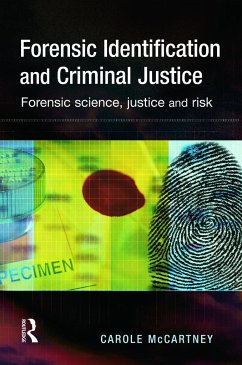Carole McCartney (UK University of Leeds)
Forensic Identification and Criminal Justice
Carole McCartney (UK University of Leeds)
Forensic Identification and Criminal Justice
- Broschiertes Buch
- Merkliste
- Auf die Merkliste
- Bewerten Bewerten
- Teilen
- Produkt teilen
- Produkterinnerung
- Produkterinnerung
This book uncovers the way in which this new reliance on forensic technologies has gained a foothold within the criminal justice system, and the risks and dangers that this can pose.
Andere Kunden interessierten sich auch für
![Law, Practice and Politics of Forensic DNA Profiling Law, Practice and Politics of Forensic DNA Profiling]() Law, Practice and Politics of Forensic DNA Profiling40,99 €
Law, Practice and Politics of Forensic DNA Profiling40,99 €![Forensic DNA Transfer Forensic DNA Transfer]() Jane Moira TaupinForensic DNA Transfer152,99 €
Jane Moira TaupinForensic DNA Transfer152,99 €![Forensic Science Forensic Science]() Christopher LawlessForensic Science40,99 €
Christopher LawlessForensic Science40,99 €![Forensic DNA Transfer Forensic DNA Transfer]() Jane Moira TaupinForensic DNA Transfer55,99 €
Jane Moira TaupinForensic DNA Transfer55,99 €![Forensic Science Forensic Science]() Christopher LawlessForensic Science152,99 €
Christopher LawlessForensic Science152,99 €![Critical Forensic Studies Critical Forensic Studies]() Roberta JulianCritical Forensic Studies40,99 €
Roberta JulianCritical Forensic Studies40,99 €![Practical Cold Case Homicide Investigations Procedural Manual Practical Cold Case Homicide Investigations Procedural Manual]() Richard H. WaltonPractical Cold Case Homicide Investigations Procedural Manual253,99 €
Richard H. WaltonPractical Cold Case Homicide Investigations Procedural Manual253,99 €-
-
-
This book uncovers the way in which this new reliance on forensic technologies has gained a foothold within the criminal justice system, and the risks and dangers that this can pose.
Produktdetails
- Produktdetails
- Verlag: Taylor & Francis Ltd
- Seitenzahl: 272
- Erscheinungstermin: 17. Mai 2012
- Englisch
- Abmessung: 234mm x 155mm x 14mm
- Gewicht: 414g
- ISBN-13: 9780415628327
- ISBN-10: 0415628326
- Artikelnr.: 35205143
- Herstellerkennzeichnung
- Libri GmbH
- Europaallee 1
- 36244 Bad Hersfeld
- gpsr@libri.de
- Verlag: Taylor & Francis Ltd
- Seitenzahl: 272
- Erscheinungstermin: 17. Mai 2012
- Englisch
- Abmessung: 234mm x 155mm x 14mm
- Gewicht: 414g
- ISBN-13: 9780415628327
- ISBN-10: 0415628326
- Artikelnr.: 35205143
- Herstellerkennzeichnung
- Libri GmbH
- Europaallee 1
- 36244 Bad Hersfeld
- gpsr@libri.de
Carole McCartney is a Senior Lecturer in the School of Law, Leeds University. Her research interests include Australian justice, innocence projects, and DNA and criminal justice.
Introduction 1. Forensic identification: the legal framework. Police
investigations and forensic identity evidence. Fingerprints and DNA
sampling: the legal framework 2. Forensic identification: the criminal
investigation. DNA and police investigations. The DNA Expansion
Programme. DNA and criminal detection rates. Forensic science and
criminal investigation: a case for caution?. Conclusion: forensic
identification and the criminal process 3. Forensic identification: the
criminal trial. The criminal trial: fairness or truth?. Identity
'matches': acceptance of fingerprint and DNA evidence. The criminal trial:
certainty and rectitude. Conclusion: forensic identification and the
criminal trial. Forensic identification and criminal justice 4. The
development of forensic identity databases. The development of forensic
identity databases. Fingerprint databasing. A sceptical approach to
forensic identity databases. Forensic identity databases: some new risks.
Forensic identity databases: current problems, future risks. Conclusion:
the endangerment of innocence in the pursuit of security 5. Forensic
identification in other jurisdictions. Europe Pan-European developments.
Interpol USA Canada New Zealand and Australia. Conclusion: England and
Wales - leading the way? 6. The future of forensic identification: issues
and prospects. Fingerprints and DNA in the 'fight against crime'. Future
applications for forensic identification technologies. Forensic
identification: human rights and civil liberties. Forensic identity
databases: issues and prospects. The 'infallibility' of forensic
identification. The information society: heading for 'information
overload'?. Conclusion: Cause for optimism, pessimism, or scepticism?
investigations and forensic identity evidence. Fingerprints and DNA
sampling: the legal framework 2. Forensic identification: the criminal
investigation. DNA and police investigations. The DNA Expansion
Programme. DNA and criminal detection rates. Forensic science and
criminal investigation: a case for caution?. Conclusion: forensic
identification and the criminal process 3. Forensic identification: the
criminal trial. The criminal trial: fairness or truth?. Identity
'matches': acceptance of fingerprint and DNA evidence. The criminal trial:
certainty and rectitude. Conclusion: forensic identification and the
criminal trial. Forensic identification and criminal justice 4. The
development of forensic identity databases. The development of forensic
identity databases. Fingerprint databasing. A sceptical approach to
forensic identity databases. Forensic identity databases: some new risks.
Forensic identity databases: current problems, future risks. Conclusion:
the endangerment of innocence in the pursuit of security 5. Forensic
identification in other jurisdictions. Europe Pan-European developments.
Interpol USA Canada New Zealand and Australia. Conclusion: England and
Wales - leading the way? 6. The future of forensic identification: issues
and prospects. Fingerprints and DNA in the 'fight against crime'. Future
applications for forensic identification technologies. Forensic
identification: human rights and civil liberties. Forensic identity
databases: issues and prospects. The 'infallibility' of forensic
identification. The information society: heading for 'information
overload'?. Conclusion: Cause for optimism, pessimism, or scepticism?
Introduction 1. Forensic identification: the legal framework. Police
investigations and forensic identity evidence. Fingerprints and DNA
sampling: the legal framework 2. Forensic identification: the criminal
investigation. DNA and police investigations. The DNA Expansion
Programme. DNA and criminal detection rates. Forensic science and
criminal investigation: a case for caution?. Conclusion: forensic
identification and the criminal process 3. Forensic identification: the
criminal trial. The criminal trial: fairness or truth?. Identity
'matches': acceptance of fingerprint and DNA evidence. The criminal trial:
certainty and rectitude. Conclusion: forensic identification and the
criminal trial. Forensic identification and criminal justice 4. The
development of forensic identity databases. The development of forensic
identity databases. Fingerprint databasing. A sceptical approach to
forensic identity databases. Forensic identity databases: some new risks.
Forensic identity databases: current problems, future risks. Conclusion:
the endangerment of innocence in the pursuit of security 5. Forensic
identification in other jurisdictions. Europe Pan-European developments.
Interpol USA Canada New Zealand and Australia. Conclusion: England and
Wales - leading the way? 6. The future of forensic identification: issues
and prospects. Fingerprints and DNA in the 'fight against crime'. Future
applications for forensic identification technologies. Forensic
identification: human rights and civil liberties. Forensic identity
databases: issues and prospects. The 'infallibility' of forensic
identification. The information society: heading for 'information
overload'?. Conclusion: Cause for optimism, pessimism, or scepticism?
investigations and forensic identity evidence. Fingerprints and DNA
sampling: the legal framework 2. Forensic identification: the criminal
investigation. DNA and police investigations. The DNA Expansion
Programme. DNA and criminal detection rates. Forensic science and
criminal investigation: a case for caution?. Conclusion: forensic
identification and the criminal process 3. Forensic identification: the
criminal trial. The criminal trial: fairness or truth?. Identity
'matches': acceptance of fingerprint and DNA evidence. The criminal trial:
certainty and rectitude. Conclusion: forensic identification and the
criminal trial. Forensic identification and criminal justice 4. The
development of forensic identity databases. The development of forensic
identity databases. Fingerprint databasing. A sceptical approach to
forensic identity databases. Forensic identity databases: some new risks.
Forensic identity databases: current problems, future risks. Conclusion:
the endangerment of innocence in the pursuit of security 5. Forensic
identification in other jurisdictions. Europe Pan-European developments.
Interpol USA Canada New Zealand and Australia. Conclusion: England and
Wales - leading the way? 6. The future of forensic identification: issues
and prospects. Fingerprints and DNA in the 'fight against crime'. Future
applications for forensic identification technologies. Forensic
identification: human rights and civil liberties. Forensic identity
databases: issues and prospects. The 'infallibility' of forensic
identification. The information society: heading for 'information
overload'?. Conclusion: Cause for optimism, pessimism, or scepticism?








